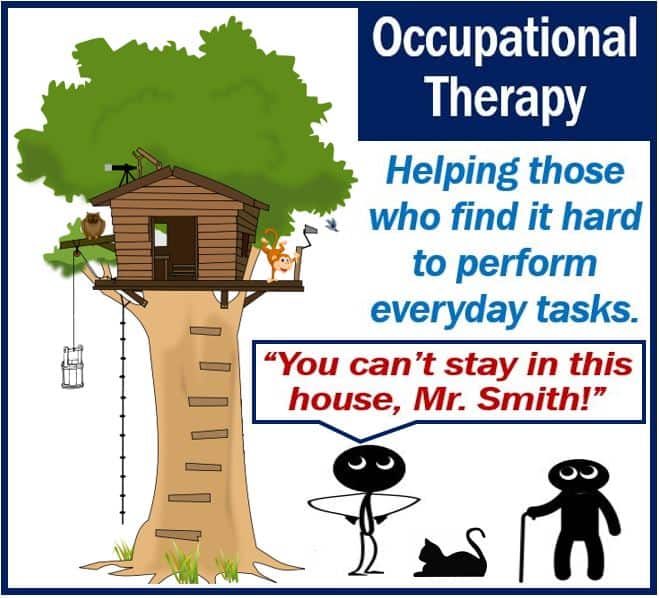Occupational therapy or OT aims to improve people’s ability to perform everyday tasks – specifically, people who are having difficulties. Occupational therapy involves the use of specific activities or aids to help people recover from mental or physical illnesses. OT is a healthcare profession that focuses on maintaining or developing the daily living and working skills people need.
Individuals who benefit from this therapy have cognitive, mental, or physical impairments.
Definition – Royal College of Occupational Therapists
According to the Royal College of Occupational Therapists in the UK, occupational therapy (OT) is a healthcare field dedicated to helping people develop, recover, or maintain the skills needed for everyday living and working. This is especially important for individuals facing physical, mental, or cognitive challenges.
Definition – American Occupational Therapy Association
According to the American Occupational Therapy Association (AOTA), occupational therapy helps people of all ages participate fully in everyday life.
It’s all about using daily activities (like self-care, work, education, and leisure) to promote health and well-being.
Occupational therapists start by getting to know you through a personalized evaluation that looks at your history, interests, and goals. From there, they create a tailored plan to improve your ability to perform everyday tasks and meet your personal objectives.
The benefits of occupational therapy can range from assistance with daily living activities (such as bathing, dressing, and eating), to providing adaptive equipment, caregiver training, and even strategies for improving memory, planning, and home safety.
These services can be offered in various settings (at home, in schools, hospitals, or community centers) ensuring support is available wherever you need it.

Who can occupational therapy help?
OT can help people with practical tasks if they:
- Have a physical disability.
- Are recovering from an operation or illness.
- Have learning disabilities.
- Are getting older and frailer.
- Have mental health problems.
Occupational therapist
An occupational therapy professional is referred to as an Occupational Therapist. They work with individuals of all ages. Occupational therapists can look at all aspects of daily life in the client’s workplace, school, or home.
The OT professional looks at activities that a person finds difficult and helps them find another way to do it.
Occupational therapists, physical therapists (UK: physiotherapists), and psychologists typically refer to the people they treat as ‘clients‘ rather than ‘patients.’ The word ‘client‘ may also refer to a ‘customer‘ with whom the seller has a business relationship. In this article, the word just means the occupational therapist’s ‘patient.’
Occupational therapy – adaptations and aids
Occupational therapists help clients with disabilities use special equipment like wheelchairs. They also help them choose and use aids for dressing, eating, mobility, and many other activities.
Occupational therapists sometimes visit clients’ homes and workplaces.
They help clients adapt their home or work environment so that they can do more things on their own. In other words, they help people become more independent at home or work.

Occupational therapy – modifying tasks
An occupational therapist can help patients by showing them new ways to perform tasks. They may also design new ways for patients to enjoy leisure activities.
Often, the occupational therapist advises people on tools or alternative methods to achieve their goals.
Occupational therapy – developing skills
If a client finds it hard to dress himself, the occupational therapist might help him improve some basic skills. For example, better motor function might make it easier to put on and take off pants and shirts.
Occupational therapists may, for example, help clients use physical exercises to get stronger. Some exercises can also improve dexterity.
There are many other types of exercises, such as mental exercises, which may improve the patient’s reasoning abilities.
Examples of how occupational therapy can help
Hip replacement
After a hip replacement operation, some people may find it hard to get in and out of a bath. Fitting grab rails in the bathroom could make that task easier.
Rheumatoid arthritis
Rheumatoid arthritis is a condition that causes pain in the joints. The joints also swell. Some people with rheumatoid arthritis may find it extremely hard or impossible to lift small objects.
Special grabbing equipment, or, for example in the kitchen, a wide-handled vegetable peeler, can make those tasks easier.
If somebody finds it hard to turn the faucets (UK: taps), it is possible to attach special faucet/tap turners.
Difficulty reaching
People, as they get older, sometimes find it difficult to reach for things, for example, in the top shelf of a cupboard in the kitchen. There are many options to choose from to make this task easier or feasible. An extended grabber is one option.
The occupational therapist might suggest relocating the cupboards lower or replacing them.
More information about OTs
Occupational therapists work in:
- Hospitals
- Offices
- Clinics
- Schools Systems
- Nursing Homes
- Home Health Agencies
- Psychiatric Hospitals
According to the US Bureau of Labor Statistics, the median annual salary for occupational therapists in the US was $93,180 in 2022.
There are, on average, 9,600 job vacancies for OTs in the US each year. Most of those openings are the result of OTs retiring, exiting the labor force, or transferring to different occupations. In May 2022, there were 134,980 OTs working in the US.
Occupational therapists spend long periods on their feet (standing up) and may have to move or lift clients.
While doctors and dentists have patients, psychologists, physical therapists, and occupational therapists have clients.
Brief history
The profession of occupational therapy is a little more than 100 years old.
It was born in the United States around the time of the First World War, when there was a need for the rehabilitation of soldiers returning from war.
The National Society for the Promotion of Occupational Therapy was founded in 1917; it later became the American Occupational Therapy Association (AOTA).
